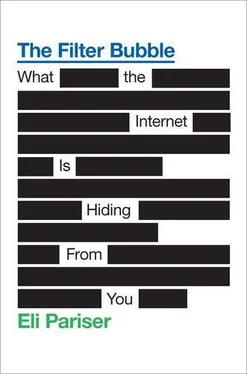But let’s say you’re more like an average American. You usually vote for candidates from one party. To the data crunchers from the opposing party, you don’t look particularly persuadable. And because you vote in presidential elections pretty regularly, you’re also not a target for “get out the vote” calls from your own. Though you make it to the polls as a matter of civic duty, you’re not that actively interested in politics. You’re more interested in, say, soccer and robots and curing cancer and what’s going on in the town where you live. Your personalized news feeds reflect those interests, not the news from the latest campaign stop.
In a filtered world, with candidates microtargeting the few persuadables, would you know that the campaign was happening at all?
Even if you visit a site that aims to cover the race for a general audience, it’ll be difficult to tell what’s going on. What is the campaign about? There is no general, top-line message, because the candidates aren’t appealing to a general public. Instead, there are a series of message fragments designed to penetrate personalized filters.
Google is preparing for this future. Even in 2010, it staffed a round-the-clock “war room” for political advertising, aiming to be able to quickly sign off on and activate new ads even in the wee hours of October nights. Yahoo is conducting a series of experiments to determine how to match the publicly available list of who voted in each district with the click signals and Web history data it picks up on its site. And data-aggregation firms like Rapleaf in San Francisco are trying to correlate Facebook social graph information with voting behavior—so that they can show you the political ad that best works for you based on the responses of your friends.
The impulse to talk to voters about the things they’re actually interested in isn’t a bad one—it’d be great if mere mention of the word politics didn’t cause so many eyes to glaze over. And certainly the Internet has unleashed the coordinated energy of a whole new generation of activists—it’s easier than ever to find people who share your political passions. But while it’s easier than ever to bring a group of people together, as personalization advances it’ll become harder for any given group to reach a broad audience. In some ways, personalization poses a threat to public life itself.
Because the state of the art in political advertising is half a decade behind the state of the art in commercial advertising, most of this change is still to come. But for starters, filter-bubble politics could effectively make even more of us into single issue voters. Like personalized media, personalized advertising is a two-way street: I may see an ad about, say, preserving the environment because I drive a Prius, but seeing the ad also makes me care more about preserving the environment. And if a congressional campaign can determine that this is the issue on which it’s most likely to persuade me, why bother filling me in on all of the other issues?
In theory, market dynamics will continue to encourage campaigns to reach out to nonvoters. But an additional complication is that more and more companies are also allowing users to remove advertisements they don’t like. For Facebook and Google, after all, seeing ads for ideas or services you don’t like is a failure. Because people tend to dislike ads containing messages they disagree with, this creates even less space for persuasion. “If a certain number of anti-Mitt Republicans saw an ad for Mitt Romney and clicked ‘offensive, etc.,’” writes Vincent Harris, a Republican political consultant, “they could block ALL of Mitt Romney’s ads from being shown, and kill the entire online advertising campaign regardless of how much money the Romney campaign wanted to spend on Facebook.” Forcing candidates to come up with more palatable ways to make their points might result in more thoughtful ads—but it also might also drive up the cost of these ads, making it too costly for campaigns to ever engage the other side.
The most serious political problem posed by filter bubbles is that they make it increasingly difficult to have a public argument. As the number of different segments and messages increases, it becomes harder and harder for the campaigns to track who’s saying what to whom. TV is a piece of cake to monitor in comparison—you can just record the opposition’s ads in each cable district. But how does a campaign know what its opponent is saying if ads are only targeted to white Jewish men between twenty-eight and thirty-four who have expressed a fondness for U2 on Facebook and who donated to Barack Obama’s campaign?
When a conservative political group called Americans for Job Security ran ads in 2010 falsely accusing Representative Pete Hoekstra of refusing to sign a no-new-taxes pledge, he was able to show TV stations the signed pledge and have the ads pulled off the air. It’s not great to have TV station owners be the sole arbitrators of truth—I’ve spent a fair amount of time arguing with them myself—but it is better to have some bar for truthfulness than none at all. It’s unclear that companies like Google have the resources or the interest to play truthfulness referee on the hundreds of thousands of different ads that will run in election cycles to come.
As personal political targeting increases, not only will it be more difficult for campaigns to respond to and fact-check each other, it’ll be more challenging for journalists as well. We may see an environment where the most important ads aren’t easily accessible to journalists and bloggers—it’s easy enough for campaigns to exclude them from their targeting and difficult for reporters to fabricate the profile of a genuine swing voter. (One simple solution to this problem would simply be to require campaigns to immediately disclose all of their online advertising materials and to whom each ad is targeted. Right now, the former is spotty and the latter is undisclosed.)
It’s not that political TV ads are so great. For the most part, they’re shrill, unpleasant, and unlikable. If we could, most of us would tune them out. But in the broadcast era, they did at least three useful things. They reminded people that there was an election in the first place. They established for everyone what the candidates valued, what their campaigns were about, what their arguments were: the parameters of the debate. And they provided a basis for a common conversation about the political decision we faced—something you could talk about in the line at the supermarket.
For all of their faults, political campaigns are one of the primary places where we debate our ideas about our nation. Does America condone torture? Are we a nation of social Darwinists or of social welfare? Who are our heroes, and who are our villains? In the broadcast era, campaigns have helped to delineate the answers to those questions. But they may not do so for very much longer.
The aim of modern political marketing, consumer trends expert J. Walker Smith tells Bill Bishop in The Big Sort, is to “drive customer loyalty—and in marketing terms, drive the average transaction size or improve the likelihood that a registered Republican will get out and vote Republican. That’s a business philosophy applied to politics that I think is really dangerous, because it’s not about trying to form a consensus, to get people to think about the greater good.”
In part, this approach to politics is on the rise for the same reason the filter bubble is: Personalized outreach gives better bang for the political buck. But it’s also a natural outcome of a well-documented shift in how people in industrialized countries think about what’s important. When people don’t have to worry about having their basic needs met, they care a lot more about having products and leaders that represent who they are.
Читать дальше











